Skira, Phaidon and Thames & Hudson: 3 Art Publishers
In Richmond upon Thames Libraries we hold a wide range of books on the history of art, design and architecture. Amongst the collection there are older books held in the Richmond Information and Reference Library Store, including titles published in the 19th century. Here is a more in depth look at three of the main art publishers behind these wonderful books. Remember, if you would like to view the books mentioned within this piece they can be borrowed from your local Richmond borough library, reference titles can be seen at Richmond Information and Reference Library.
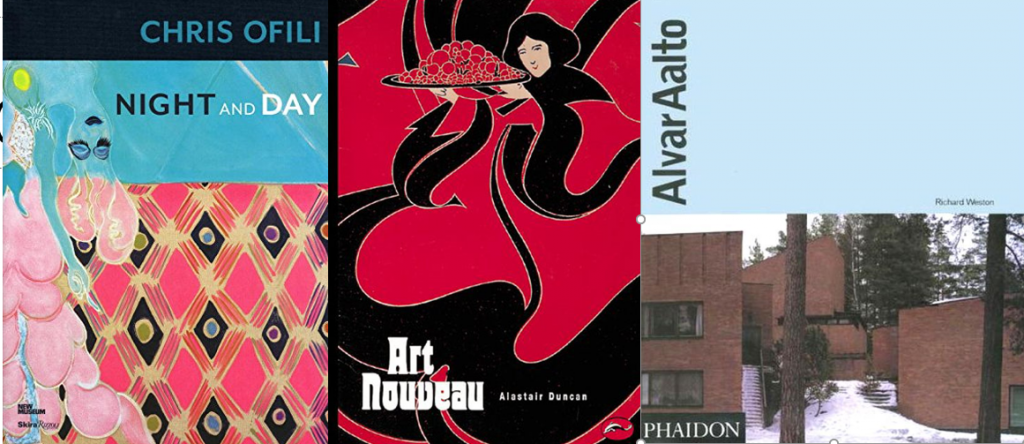
Publishing during and after the Second World War
Out of necessity book publishing was scaled back during the Second World War. Paper rationing was introduced in February 1940 and book and newspaper publishers were forced to reduce the amount of paper they used. For example, The Guardian consisted of sixteen pages in 1939 but by 1941 this had been reduced to just six. In the post war years, once paper rationing was lifted, publishing and in particular art publishing flourished. This could possibly have been because, after so much had been destroyed or lost during the war, art was valued and appreciated all the more.
It took around five years after the war ended for the supply of paper to become plentiful, and this, combined with advances in printing technology which enabled faster printing in larger volumes, led to a growth in art history publishing. Photocomposition machines had been around since the end of the C19th but it wasn’t until the 1950s that machines became widely available and in the 1960s they were combined with digital computers to make the process of printing even faster and less expensive.
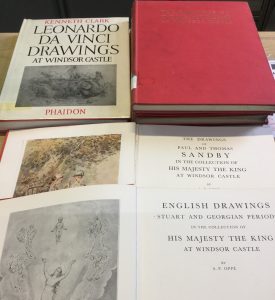
Phaidon
Phaidon* was founded in Vienna in 1932 by Dr Bela Horovitz and Ludwig Goldscheider. Their first books weren’t on art history but on philosophy, history and literature. Their aim was to provide good quality, well-designed affordable books. In 1937 the first large format art history titles were published on: Van Gogh, Botticelli and the French Impressionists. They had high quality colour plates and were were aimed at the US and British markets.
In the late 1930s, with the threat of the annexation of Austria by Nazi Germany looming, many Austrians emigrated. Horowitz and Goldscheider, with the help of the British publisher Sir Stanley Unwin of George Allen and Unwin Ltd. moved themselves and their business to London. Despite wartime rationing Phaidon continued to publish, and in 1942 the first volume of the critical catalogue of drawings in The Royal Collection at Windsor Castle appeared, the series would continue for the next 30 years. Many of these are available to see at Richmond Information and Reference Library.
The Story of Art
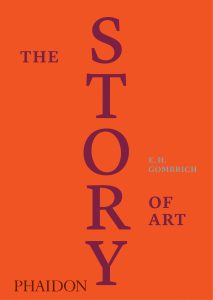 Phaidon’s best known title, which is still in print, is the The Story of Art written by Ernest Gombrich. He was another escapee from pre-war Vienna. Horovitz had a chance encounter with Gombrich on the top deck of a London bus (it isn’t clear whether they knew each other from when they both lived in Vienna) and the idea for the book was sown. Gombrich did get cold feet but Horovitz refused to take back the advance and the book was eventually written and published in 1950.
Phaidon’s best known title, which is still in print, is the The Story of Art written by Ernest Gombrich. He was another escapee from pre-war Vienna. Horovitz had a chance encounter with Gombrich on the top deck of a London bus (it isn’t clear whether they knew each other from when they both lived in Vienna) and the idea for the book was sown. Gombrich did get cold feet but Horovitz refused to take back the advance and the book was eventually written and published in 1950.
Gombrich talks in the preface to the first edition about thinking of teenager readers when he was writing (I read it aged 18 prior to going to art school) and wanting to provide them with a way of orientating themselves in the world of Western art and enabling them to navigate through the wealth of names, periods and styles. Grombrich also mentions the artists he had to omit which was necessary so that the book didn’t become unwieldy and too daunting.
The Story of Art is designed to inspire the reader to want to find out more, with Gombrich suggesting other reading material. The end result is a very readable, accessible book which provides a launchpad into the world of Western art. In the preface to 15th edition, Gombrich says “I feel the need to emphasise once more that this book is intended to be enjoyed as a story”. Like all great writers and teachers he makes learning about the history of art a pleasure.
The latest edition, the 16th, was published in 1994. It has been constantly revised over the years with more and more colour images replacing the black and white ones. The current luxury edition is entirely composed of colour images. Additional artists have been added including: Corot (one of the omissions that Gombrich had regretted), Kathe Kollwitz, and Emile Nolde. The 20th century chapter was expanded.
Other historians and art historians who were published by Phaidon include: Sir Kenneth Clark, Anthony Blunt and Rudolf Wittkower.
Phaidon continues to be a major art history publisher.
Titles published by Phaidon that you will find on the shelves of Richmond upon Thames Libraries include: Conceptual Art, Land and Environmental Art, Georgia O’Keeffe, Alvar Aalto and Sir John Pope-Hennessy’s Introduction to Italian Sculpture.
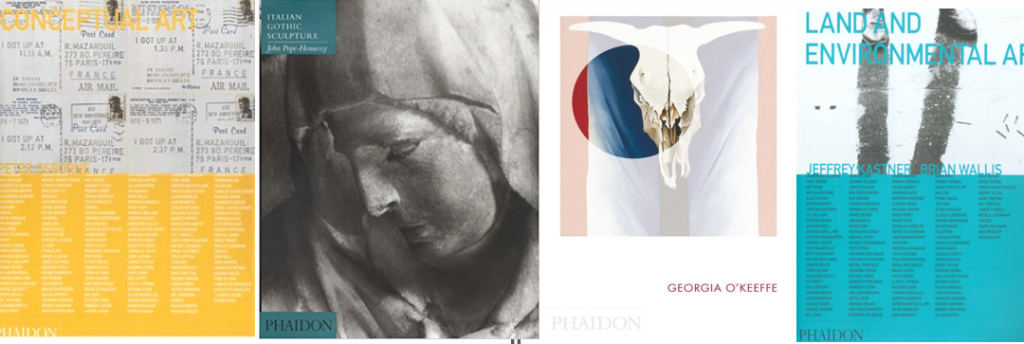
Skira
The company was founded by Albert Skira in Lausanne in 1928, but later the company moved to Geneva and in the 1930s they opened an office in Paris. From the beginning there was direct contact with artists. The first title published was Ovid’s Metamorphoses with etchings by Pablo Picasso. Titles were aimed at the international market and were translated into English.
In the 1950s Skira began producing what where known as their Grand Books series. These featured very high quality applied plates – these are separate colour plates that are glued into the book. (These are a nightmare for librarians as they can be removed, and sometimes are, and they are stamped on the back with a library stamp to deter removal). Richmond upon Thames Libraries hold several volumes of The Great Centuries of Painting series. Because of the quality of the colour reproductions they remain excellent books on their subjects. Titles include: Roman, Egyptian and Greek painting.
Albert Skira died in 1973 and the company was sold. They are now part of the American Rizzolli publishing company and the company is called Skira Rizzolli. They continue to publish high quality art books and in particular exhibition catalogues.
Titles published by Skira that you will find on the shelves of Richmond upon Thames Libraries include: Edvard Munch 1863-1944, Anselm Kiefer, Don McCullin, Chris Ofili and James Stirling.

Thames & Hudson
Thames & Hudson was founded in September 1949 by Walter and Eva Neurath with ten titles being published in their first year. Walter Neurath** was born in Vienna in 1903, and just like Dr Bela Horovitz, Ludwig Goldscheider and Gombrich, he left Vienna in 1938 and moved to London. In Vienna he had run an art gallery and had published art books. Before setting up the company Walter worked as a production manager for Adprint and was responsible for producing the King Penguin series. He was later responsible for producing the New Naturalist series for Collins. Interestingly, the idea of a series of linked publications was much more common in Europe than it was in England at that time.
Eva was born in Berlin and came to England in 1938. She worked with Walter at Adprint where she became head of the art department. They founded Thames and Hudson together as business partners and were later married in 1953.
Their aim was to create what they called a “museum without walls” and to make the world of art and the research of top scholars available to the public at affordable prices. Walter and Eva’s background in book production and design meant that they had the practical knowledge that enabled them to produce stylish, well-designed books at reasonable prices. The books were designed so that text and illustrations were integrated and there was a high proportion of colour illustrations used.
Neurath was often the first publisher to recognise the talents of new artists, and he published the first books on painters such as Sidney Nolan, Arthur Boyd, Jackson Pollock, and many more.
Writers for Thames and Hudson have included: H. R. Trevor-Roper, Asa Briggs, A. J. P. Taylor and Herbert Read.
The origin of the name
Using the names of the rivers flowing through London and New York was to reflect the international outlook of the company, and the two dolphins that are part of the logo, symbolise friendship and intelligence, with one facing east and the other west, suggesting a connection between the old world and the new. There is a mosaic of their logo on the doorstep of 30 Bloomsbury Street where Thames and Hudson used to be based.
The World of Art series
The World of Art series was launched in 1958. The series is published in paperback so as to be more affordable than hardbacks. The series has done as much to encourage the study of history of art as Gombrich’s The Story of Art. Volumes are pocket sized with distinctive black spines and are highly illustrated. Over 300 titles have appeared in the series and they cover a huge range of subjects.
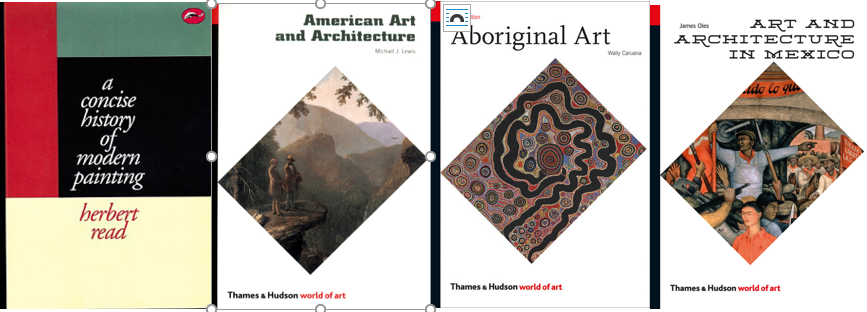
Walter Neurath died in 1967 with Ewa succeeding him as chair. The company is still family run. Their titles are translated into major European languages and are sold across Europe and they continue to be a major publishers of art history titles.
Conclusion
All these companies continue to publish high quality books many of which you will find on the shelves of your local library. Some monographs may have been published years ago, but as they are still major works of scholarship, with high quality colour reproductions, they still hold a place on library shelves.
*Phaidon was named after a pupil of Socrates and was said to reflect its founder’s love of classical antiquity and culture and the company’s distinctive logo derives from the Greek letter phi, which represents the golden ratio.
**While in Vienna, Gombrich had began to write a short history of the world for children. It was published in 1936, and published in English in 2005 as A Little History of the World, by Walter Neurath.
Library members can use their library card to log in to the links to biographical entries in the Oxford Dictionary of National Biography
